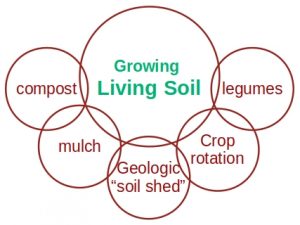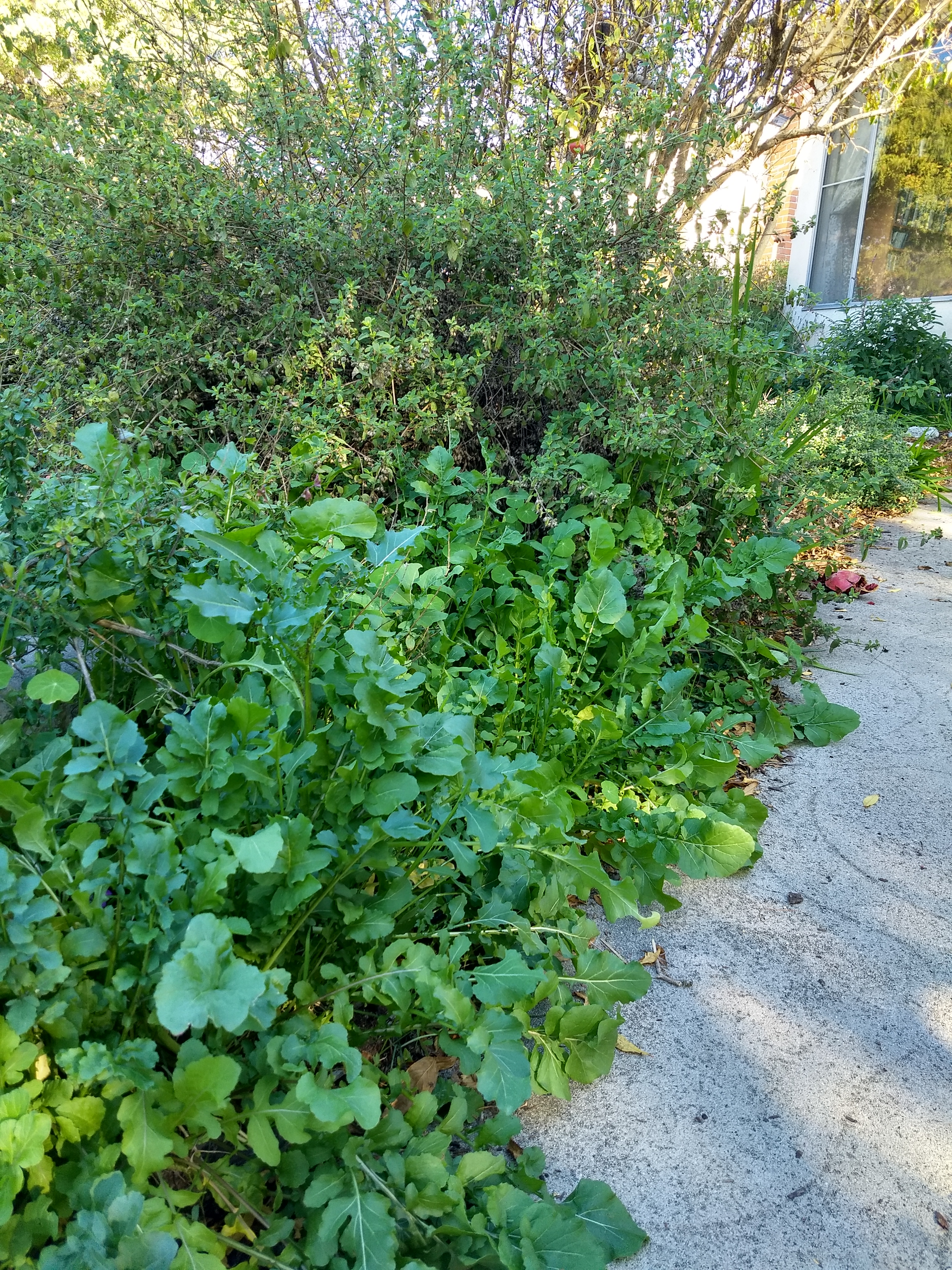
Resources for my Soil Building class
 When we pull harvest from the garden, week after week, we are taking from the garden ecosystem. We are taking from the soil.
When we pull harvest from the garden, week after week, we are taking from the garden ecosystem. We are taking from the soil.
Here in Southern California, where we can harvest year-round (with a seasonally-appropriate crop mix), that means we are taking from the soil constantly. In order to maintain basic soil fertility, we must always be building-building-building up our soil.
That means compost, it means mulch, it means worm castings, it means doing all the things that cultivate rich, alive, healthy organic garden soil.
Here are some resources we mentioned during my soil-building garden classes:
“Feed your soil. Your soil feeds your plants, and your plants feed you.” (paraphrasing John Jeavons)
- Feed your soil organisms. They are the ones who feed your plants (according to Lowenfels), and your plants feed you!
SLIDES for my March 13, 2022 soil-building class (coming soon)
- Slides pdf, via GoogleDrive … I’m not sure if this link will work
- Slides pdf, via my Podia page … email sign-in will be requested
DIY soil testing (free how-to sheet – pdf) – (via my Podia page. email sign-in will be requested)
- additionally: Permaculture observation , and Test your Soil with Plants, by John Beebe. (I use Weeds of the West, edited by Tom Whitson, to assist me in identification.)
Living soil
- Like all living organisms, soil critters need Food, Water, Shelter & Protection, and a Place to raise young. (jingle from the National Wildlife Federation’s Backyard Wildlife Habitat program)
- Teaming with Microbes, by Jeff Lowenfels & Wayne Lewis
- Compost Critters, by Bianca Lavies
- my blog posts on living soil: About mycorrhizal fungus , Living soil
- Think of yourself as being a “worm farmer” with the goal of growing bountiful soil life.
- “Living soil” means an entire ecosystem of organisms – eating, pooping, reproducing, and interacting with all the other species. So you can’t just go to a garden center and buy a carton of “earthworms,” dump it in, and call it done.
- For anything you might consider adding to the garden, ask yourself “what will this do for the soil critters? how can I benefit them?” The answer will guide you to best practices.

Compost
- Food for your soil critters
- things that used to be plants
- Fine-textured, mostly decomposed. in other words, you can’t tell what it used to be.
- add compost EVERY time you go to plant
- mix it into your garden soil.
- my blog series on compost: What is good compost? , Nourishing with compost , Compost happens , More compost,
- Worm composting resources from the U.S. EPA , from Cornell University Extension
- exception: California native plants. Habitat restoration expert Nicholas Hummingbird teaches that soil mixes are too rich for our native plants. For these plants, don’t add compost. Instead, plant directly into the existing soil you have.
Mulch
- Protection for your soil critters, plus long-term food supply.
- Coarse-textured, not decomposed. Examples: wood chips, straw, shredded paper.
- layer on top of your soil, like “putting a quilt on your bed”
- my blog series on mulch: What is good mulch? , A thick quilt of mulch , How much mulch? ,
- carbonaceous or not?
- Lowenfels & Lewis teach us that trees and perennials crave carbonaceous mulch like wood chips. For annuals like vegetables, use the more-easily-broken-down mulches, like straw, leaves, paper.
- Habitat restoration expert Nicholas Hummingbird teaches that California native plants shouldn’t be mulched. Instead, plant groundcover native plants to shade your soil.
- green mulch versus cover cropping
- the term “green mulch” is often used for the practice of growing beneficial plants in between areas – for instance growing clover between rows of fruit trees, where the clover is periodically cut and left to decompose. It isn’t really something that fits into urban gardening practices.
- the term “cover cropping” refers to the practice of growing restorative plants on a bed that is fallow, or not-being-used. If you are skipping a season (for instance you only grow vegetables in the summer season) you should consider growing legumes or clover as a cover crop when your garden is out-of-use.
- great cover crops for Southern California’s cool season: peas, fava beans, clover, buckwheat
To till or not to till, that is the question
-
- the reason behind no-till practices is to preserve the long fibers of mycorrhizal fungus.
- if you have Bermuda grass in your garden, there is no question. You must remove the Bermuda, which unfortunately means you must disturb your soil. How do you get rid of Bermuda grass?
- if your garden is (miraculously) Bermuda-grass-free, or a section of your garden is Bermuda-grass-free, you have the option of trying no-till. To do this, layer additions of compost on top of your existing garden soil. The larger organisms within the soil life — such as earthworms — will do the tilling for you. (trust them)
Geologic “soil shed”
- the basic “bones” of your garden
- Zoom out on Google maps: what are the massive, geologic-scale, pre-existing (and unalterable) conditions within which your garden exists? (examples: river bottom, sand dune, beach, ancient riverbottom/sandstone, volcanic or glacial deposit)
- Much of Westchester is a sand dune. When you view it in “zoom out” perspective, it’s clearly part of a series of dunes which are visible west of Pershing, west of LAX.
- Much of Culver City, Marina del Rey, Playa Vista is mostly clay. Before L.A. was built out, the L.A. River alternated between reaching the ocean via San Pedro, and reaching the ocean via Ballona Creek.
- soil pH in Southern California
Crop rotation
- my crop rotation series: what can crop rotation do for you? , when to rotate crops in Southern California
- Vegetable Crop Rotation Wheel
- my free garden app at VegGarden365.com — use it through your web browser to tell what to plant when in Southern California
Legumes
Other topics
- Starting a New Garden – here’s what we did with “virgin soil” to jump-start the Community Garden at Holy Nativity the very first year. (Once your garden is established, you don’t have to do these things)
- what’s a more-sustainable garden?
- What should I plant? , What to plant when in Southern California
- What about raised beds?
- Hydrophobic: what to do when your soil is too dry
- how to grow a garden in an apartment or rental
- backyard wildlife habitats , native milkweed for monarchs
- The bad and the ugly: Bermuda grass , How do you get rid of Bermuda grass , Bermuda grass containment in a frost-free area , Bermuda grass removal (infographic)
- it all works together as an ecosystem: see my Permaculture resources
Want more? get my latest posts, as soon as they come out: Subscribe, and be sure to check “gardening books and tips”
TinyURL for this post = tinyurl.com/2kc6rv2c



One Comment
Lori
Very useful information. Thanks for posting this.